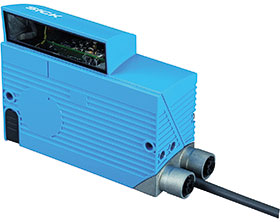

SICK has introduced its new CLV615 dual port bar code scanner, featuring an integrated switch that makes it easy to install the sensor in a Profinet IO network. Installation in a line and ring topology reduces the amount of cabling, time and money required for mounting, whilst the compact housing, simple configuration and reading field optimised for intra-logistics make it quick to integrate into a conveyor system.
With the CLV615 Dual Port, SICK has added to its portfolio of flexible fieldbus identification sensors. A bar code scanner with a Profinet dual port already integrated into the housing now complements the Profinet on board single port for bar code scanners, image-based code readers and RFID devices. This means that either the existing solution with the external CDF600-2 fieldbus module or the variant with dual port on board can be used to integrate the scanner in a ring topology as required. The cross-technology platform strategy, 4Dpro, guarantees that all devices are compatible in terms of network connection and can be linked in a network with other SICK ID sensors.
CLV61x dual port – the network pro
This compact laser scanner is the optimum solution for identification within picking and conveyor systems. With a scanning frequency of up to 1000 scans per second and a reading field of between 25 and 330 mm, it is ideally suited for intra-logistics. Even where space is limited, the compact housing with rotating system plug makes it is easy to mount. In addition to the two Speedcon-compatible connections (M12 female connector), an integrated power cable with an M12 male connector provides a simple power supply via a flat ribbon cable. A total of five LEDs provide detailed status in-formation for the scanner, so faults can be rectified in an efficient and targeted manner.
Flexible configuration for flexible networks
There are a number of different configuration methods. As well as typical configuration direct in the control environment (via a GSDML file), the scanner can also be configured using the SOPAS ET user interface. Diagnosis and reconfiguration are made easy by an auxiliary USB interface, as well as the two Ethernet ports. To save time, identical control and software structures and settings can be duplicated in further sensors, speeding up the commissioning process. If the bar code scanners are installed in a ring topology, the redundant setup means that the system is guaranteed to continue running, even if there is an isolated fault in the cable or a field device. This is due to the fact that the CLV615 Dual Port supports the media-redundant protocol, thereby ensuring continued data communication with every device in the network after a short switching time.
For more information contact Mark Madeley, SICK Automation SA, +27 (0)11 472 3737, [email protected], www.sickautomation.co.za
| Tel: | +27 10 060 0550 |
| Email: | [email protected] |
| www: | www.sick.com/za/en/ |
| Articles: | More information and articles about SICK Automation Southern Africa |

© Technews Publishing (Pty) Ltd | All Rights Reserved